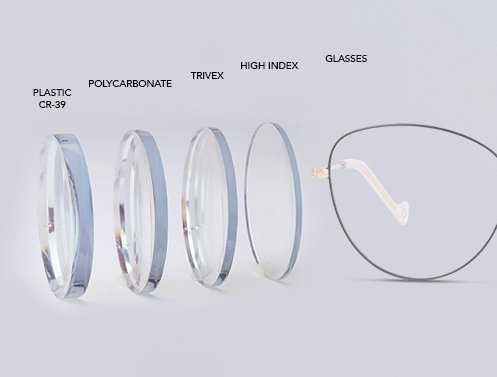Lens Materials in Glasses
Glasses are a popular accessory worn by millions of people around the world. One of the most important components of glasses is the lens. Lenses come in a variety of materials, each with their own unique properties and benefits. In this post, we will explore the different types of lens materials made in glasses.
1.Glass lenses
Glass lenses are the oldest type of lenses used in glasses. They are made from a mixture of silica, soda, lime, and other minerals. Glass lenses are highly resistant to scratches and provide excellent optical clarity. However, they are heavy and can break easily, making them less popular than other types of lenses and are now more difficult to get.
2. Plastic lenses
Plastic lenses are made from a type of plastic called CR-39, which is a lightweight, shatter-resistant material. They are a popular choice for eyeglasses because they are affordable, lightweight, and provide excellent optical clarity. They can also be coated with various types of coatings, such as anti-reflective or scratch-resistant coatings.
3. Polycarbonate lenses
Polycarbonate lenses are a type of plastic lens that is highly impact-resistant. They are often used in safety glasses, sports glasses, and children's glasses because they are difficult to break. They are also lightweight and inexpensive. However, they are more prone to scratches than glass or other plastic lenses and have poorer optical quality.
4. Trivex lenses
Trivex lenses are a newer type of lens material. They are made from a material that is very lightweight, impact-resistant, and provides excellent optical clarity. Trivex lenses are also more scratch-resistant than polycarbonate lenses, making them a popular choice for people who are hard on their glasses. Because they are difficult to break, they are also a great choice for safety glasses, sports glasses, and children’s glasses.
5. High-index lenses (1.67, 1.70, 1.74)
High-index lenses are a type of lens material that is designed to be thinner and lighter than traditional plastic lenses. They are made from a type of plastic that has a higher refractive index, which means that they bend light more efficiently than other types of lenses. High-index lenses come in various indices, the higher of which create a thinner profile, however the quality of optics isn’t necessarily better. High-index lenses are a popular choice for people with high prescriptions because they can reduce the thickness and weight of the lenses.
In conclusion, the type of lens material used in glasses can have a significant impact on their performance and durability. Glass lenses provide excellent optical clarity but are heavy and can break easily. Plastic lenses are affordable, lightweight, and provide excellent optical clarity. Polycarbonate lenses are highly impact-resistant but are more prone to scratches. Trivex lenses are similar to polycarbonate but are more scratch-resistant with better optical quality. High-index lenses are thinner and lighter than traditional plastic lenses and are a popular choice for people with high prescriptions. Ultimately, the choice of lens material will depend on a person's individual needs and preferences.



